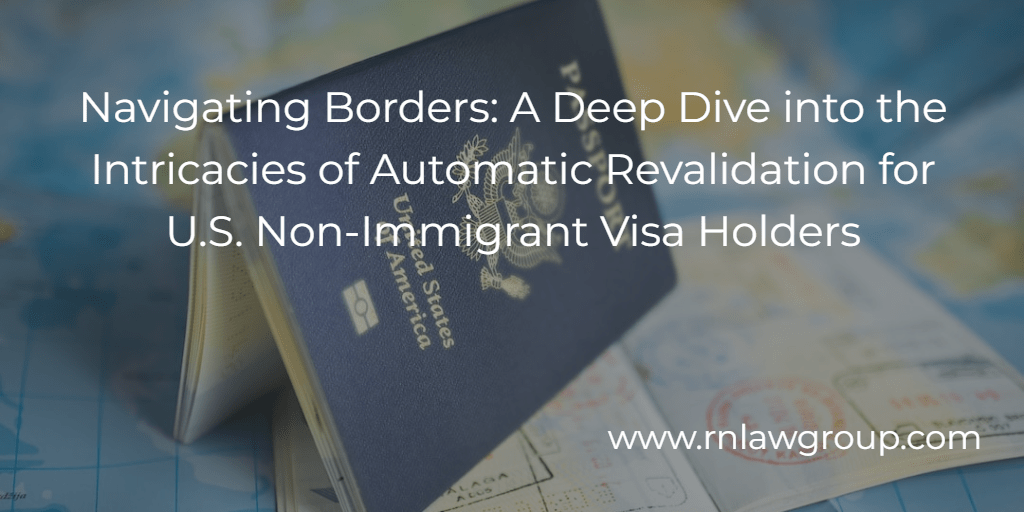
Navigating Borders: A Deep Dive into the Intricacies of Automatic Revalidation for U.S. Non-Immigrant Visa Holders
Introduction:
In an era characterized by global mobility, the ability to travel international borders seamlessly is a critical consideration for non-immigrant visa holders in the United States. Among the myriad regulations governing such travel, Automatic Revalidation stands out as a unique provision, offering certain visa holders the privilege of re-entering the U.S. without the need for a new visa stamp. This article aims to provide an in-depth exploration of Automatic Revalidation, shedding light on its eligibility criteria, limitations, and the intricate process involved.
What is Automatic Revalidation?
Automatic Revalidation, a nuanced process rooted in U.S. immigration regulations, allows specific non-immigrant visa categories to re-enter the United States following a short visit to contiguous territories—Canada or Mexico—without the arduous task of obtaining a new visa stamp. Let’s delve into the intricacies of this provision, explaining its complexities:
Eligibility Criteria:
Automatic Revalidation extends its benefits to a select group of non-immigrant visa categories. To qualify for this provision, individuals must meet the following stringent criteria:
- Non-Immigrant Visa Types: Automatic Revalidation primarily caters to individuals holding expired U.S. visas in specific categories, including B (visitor), F (student), J (exchange visitor), M (vocational student), TN, and certain H (temporary worker) visas.
- Short Trips to Contiguous Territories: The provision mandates that the individual’s travel to contiguous territories (Canada or Mexico) be brief, not exceeding a 30-day period. The purpose of the trip should align with activities such as tourism, business meetings, or short-term studies.
- Valid I-94 Arrival/Departure Record: Ensuring legal status in the United States is essential. Individuals must possess a valid Form I-94, the Arrival/Departure Record, indicating their authorized stay.
- Unexpired Passport: The individual’s passport must be valid at the time of re-entry, adding another layer of consideration to the eligibility criteria.
Limitations and Nuances:
While Automatic Revalidation offers a streamlined approach to re-entry, it comes with its own set of limitations and nuanced considerations:
- Contiguous Territory Restriction: The provision strictly confines travel to contiguous territories—Canada or Mexico. Any deviation from this limitation necessitates obtaining a new visa before returning to the United States.
- Visa Category Specificity: Automatic Revalidation applies solely to individuals with expired visas falling within the B, E, F, J, M, TN and certain H visa categories. Other visa categories are excluded from this privilege.
- Security Clearances and Waivers: Individuals subject to security clearances or those who have received a waiver of ineligibility may face heightened scrutiny, potentially rendering Automatic Revalidation unavailable in certain cases.
The Intricate Dance of Automatic Revalidation:
Navigating the process of Automatic Revalidation requires a careful choreography of steps to ensure a smooth re-entry into the United States:
- Journey to Contiguous Territory: The first step involves traveling to either Canada or Mexico for a short trip, adhering to the stipulated timeframe.
- Documentary Scrutiny: Upon returning to the U.S., immigration officers meticulously scrutinize the individual’s documents. This includes the examination of the expired visa, a valid passport, and the Form I-94.
- Admissibility Assessment: The individual’s admissibility to the U.S. is assessed, taking into account the purpose of the trip, compliance with visa regulations, and other eligibility criteria.
- Potential Secondary Inspection: In certain instances, individuals may find themselves directed to secondary inspection for a more thorough examination, especially if security concerns or waivers are in play.
Now that we have explained what Automatic Revalidation is and its process, let’s address some frequently asked questions (FAQs) related to Automatic Revalidation:
- What is Automatic Revalidation, and how does it benefit non-immigrant visa holders?
- Answer: Automatic Revalidation is a provision that allows certain non-immigrant visa holders to re-enter the United States without obtaining a new visa stamp after a short trip to contiguous territories (Canada or Mexico). It simplifies the re-entry process, saving time and effort.
- Can Automatic Revalidation be used for travel to countries other than Canada or Mexico?
- Answer: No, Automatic Revalidation is limited to travel to contiguous territories—Canada or Mexico. Travel to any other country requires obtaining a new visa before returning to the United States.
- Is there a time limit for the trip to Canada or Mexico under Automatic Revalidation?
- Answer: Yes, the trip to contiguous territories should be brief, not exceeding 30 days. The purpose of the trip should be related to activities such as tourism, business meetings, or short-term studies.
- What documents are required for Automatic Revalidation?
- Answer: To utilize Automatic Revalidation, individuals must have an expired visa in eligible categories, a valid passport, and a Form I-94 indicating their legal status in the United States.
- Can individuals with security clearances or waivers use Automatic Revalidation?
- Answer: Individuals subject to security clearances or those with waivers of ineligibility may face additional scrutiny. Automatic Revalidation may not be available in certain cases.
- What happens if an individual travels beyond Canada or Mexico during the short trip?
- Answer: Automatic Revalidation is not applicable for travel to countries other than Canada or Mexico. If an individual travels elsewhere, they must obtain a new visa before returning to the United States.
- Is there a risk of denial or additional inspection during the re-entry process?
- Answer: While the majority of cases proceed smoothly, there is a possibility of secondary inspection, especially for individuals with security concerns or waivers. Adherence to immigration regulations is crucial.
- How can individuals stay informed about changes or updates to Automatic Revalidation rules?
- Answer: It’s essential to regularly check the official U.S. government websites, such as the U.S. Department of State and U.S. Citizenship and Immigration Services (USCIS), for the latest information and updates on immigration regulations.
Conclusion:
Automatic Revalidation emerges as a valuable ally for non-immigrant visa holders navigating the complex landscape of international travel. Armed with a comprehensive understanding of the eligibility criteria, limitations, and the nuanced process involved, individuals can leverage this provision when embarking on journeys to contiguous territories. In the realm of immigration, knowledge is power, and staying informed while seeking guidance from relevant authorities ensures a seamless and stress-free travel experience.
By: Felipe Jimenez
Felipe Jimenez is an Associate Attorney at Reddy Neumann Brown PC He works in the H-1B Department where he assists clients through all phases of the non-immigrant visa process.
Reddy Neumann Brown PC has been serving the business community for over 20 years and is Houston’s largest immigration law firm focused solely on US. Employment-based immigration. We work with both employers and their employees, helping them navigate the immigration process quickly and cost-effectively.

